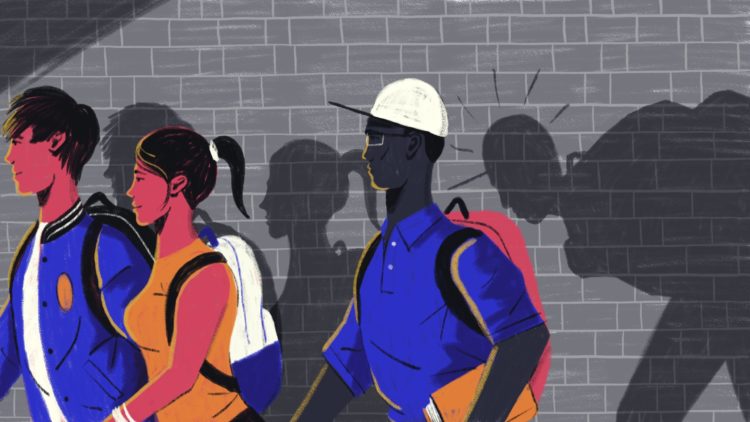Because some groups of students may be negatively stereotyped by teachers or other adults and peers, or may develop negative self-images through the normal course of growing up, growth mindset interventions in schools can be thought of as buffering oppressive messages that emanate from our society at large. In light of this I am often asked, “Wouldn’t it be better to attack discrimination and bias, and their consequences, at the root?” Some reasonably wonder, that is, if it would be more worthwhile to directly fight the contexts of oppression, discrimination, and prejudice rather than focusing on programs or practices that operate within those contexts.
These are excellent questions, of course, and my team and I—and many researchers who focus on using mindset research to reduce inequality—think about them a lot.
I’d like to lay out two thoughts that respond to these questions, neither of which is meant to be entirely comprehensive: one having to do with non-mindset causes of achievement and the other with the root causes of bias and discrimination.
The program, policy, or practice is not the end.
First, mindset researchers would never argue that “All students need is a growth mindset, not a good teacher or a safe school to learn in.” The theory that Greg Walton and I laid out in 2011 is that a mindset intervention can make the benefits of a teacher’s instruction more apparent, but it is no replacement for the instruction itself. To truly address inequality in academic or social outcomes, we need to provide students with appropriate resources but also psychologically support them to take on the intellectual challenge of learning.
To truly address inequality in academic or social outcomes, we need to provide students with appropriate resources but also psychologically support them to take on the intellectual challenge of learning.
A good illustration of this point comes from the community college math reform launched by Tony Bryk and colleagues when I was a fellow at the Carnegie Foundation for the Advancement of Teaching. In an effort to improve success rates in development math, sometimes called remedial math—a setting that shows strong racial, ethnic, and socioeconomic inequalities—we developed the Statway, which teaches students college-level statistics but embeds developmental math (i.e., algebra) within the course as a just-in-time support. The course is accelerated relative to the typical two- or three-year sequence, getting students to and through math requirements in just one year. Yet this rigorous course was delivered to adults who felt that they were not “math people” and who, as Professor Jim Stigler put it, had “math scar tissue” from years of failing at math. However, opening access to high-quality coursework but failing to address mindsets may only have heightened old fears and pushed students away. We therefore added a growth mindset treatment to the beginning of the Statway—a treatment that became the predecessor to the materials used in our current work, the National Study of Learning Mindsets. The treatment succeeded in helping students develop a growth mindset, and student changes in mindsets were excellent predictors of success in the course. Ultimately, the Statwaytripled the success rates of community college math students in half the time and has done so in every college where it has been scaled up so far. It now benefits thousands of students per year. This is just one example of how a “both/and” approach—changing both mindsets and learning opportunities—can be key to improving outcomes and reducing inequality.
The overall context can be a piece of the intervention.
The second question has to do with the pernicious racial, ethnic, religious, and socioeconomic stereotypes, biases, and stigmas that groups face in the United States and around the world. Giving a student a growth mindset, for instance, does not erase the social contexts that may treat one’s group disrespectfully or result in segregation. Instead, the mindset may help a student cope so that, given the current state of affairs, he or she can still make some progress toward a more prosperous future.
Giving a student a growth mindset, for instance, does not erase the social contexts that may treat one’s group disrespectfully or result in segregation. Instead, the mindset may help a student cope so that, given the current state of affairs, he or she can still make some progress toward a more prosperous future.
We may also think about context itself as a piece of the intervention. One question to ask is: If we paired a student intervention with a shift in the social context, how might the effect be magnified even further?
We can begin to look into this with data from the National Study of Learning Mindsets on school and classroom contexts, including a large number of measures of the classroom and school environments that may contribute to educational inequalities writ large.
For example, the National Study of Learning Mindsets included a survey of over 90% of the math teachers of 9th grade students in the study. On that survey we included what is considered to be the best measure of teachers’ implicit racial biases: Keith Payne’s Affect Misattribution Procedure (AMP). On the AMP, teachers are shown either a White face or a Black face. Next, they see a pictogram that looks like a Chinese character. Finally, they guess whether the pictogram represents a pleasant or an unpleasant word. It turns out that when people feel strong positive emotion to a face they guess that the pictogram is pleasant, but when they feel strong negative emotion to a face they guess that the pictogram is unpleasant. This can give a sense of people’s racial biases. (In a famous study of the 2008 U.S. presidential election, a nationally representative sample of Democrats who were high on anti-Black bias refrained from voting rather than vote for Barack Obama.) We administered the AMP with a national sample of teachers, to our knowledge for the first time. Data from the National Study of Learning Mindsets can therefore identify whether and to what extent teachers’ biases predict educational outcomes, such as who gets placed into advanced math in 10th grade.
Our goal is to use correlational data taken from this study, the most current representative sample study of 9th graders in the United States, to describe the factors that seem to predict inequalities in outcomes. We’ve done this by launching an early career fellows program whereby outside scholars can gain early access to the National Study of Learning Mindsets data from the University of Texas at Austin Population Research Center and can publish papers on the mindset environment and educational inequality. We hope this feeds directly into new, context-focused interventions while also elevating the careers of up-and-coming scholars.
Conclusion
Effective mindset interventions seem like a good thing to do for students right now, given that we know that far more students could be successful than currently are successful. But ideally, such interventions will be paired with effective methods to change cultural biases and stereotypes themselves.
By conducting research to build, test, or increase understanding of specific programs, policies, or practices to reduce inequality, we are not turning a blind eye toward the larger context in which inequalities exist. Rather, we are seeking to improve outcomes and opportunities for young people and families by developing a foundation for them to get ahead. Ultimately, with an eye toward the root of the challenge, approaches to reducing inequality at the branch can lead to change in the long run.
















